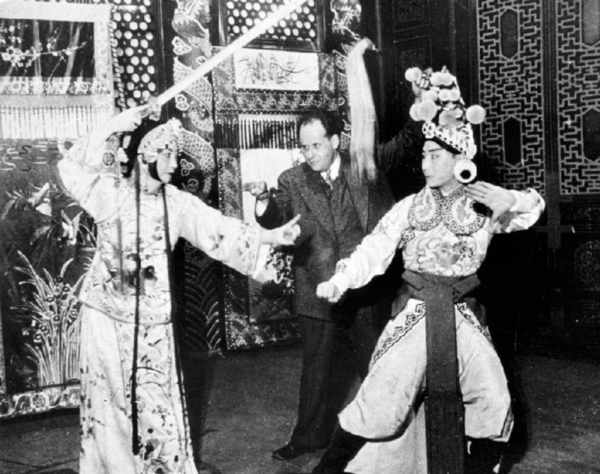China Daily|When pioneers of Montage met Chinese culture
作者: 编辑:陈舒婷 来源:中国日报 阅读:
发表时间:2025-05-17
作者: 编辑:陈舒婷 来源:中国日报 发表时间:2025-05-17
在习近平总书记对俄罗斯进行国事访问,并出席纪念苏联伟大卫国战争胜利 80 周年庆典的重要时刻,在中俄人文合作委员会电影合作分委会第十八次会议于莫斯科召开之际,中俄两国的文化交流文明互鉴持续深化,合作共建稳步推进,切实增进两国人民的福祉。如今,跨境旅游蓬勃发展,产业园区建设日新月异,电影行业的交流也愈发深入。两国人民正携手并肩,迈向互利共赢、睦邻友好的新时代。在此背景下,中国美术学院电影学院副院长付帆受《中国日报》“XI’S VISIT”专栏邀请,以《When pioneers of Montage met Chinese culture》为题回溯中俄电影的历史渊源与文化互鉴,并分享其独到见解。

本文刊登于《中国日报》2025年5月10日4版“习近平总书记访俄”专栏
When pioneers of Montage met Chinese culture
蒙太奇先驱与中国文化的相遇
By FU FAN
Deputy dean at the School of Film Art,China Academy of Art
【文】 付帆
中国美术学院电影学院副院长
Nestled in Moscow's Mira Avenue, the State Central Cinema Museum boasts a unique permanent exhibition — a meticulous reconstruction of Sergei Eisenstein's apartment. Filled with hundreds of his personal artifacts, the exhibition serves as a testament to the cultural developments that shaped the artistic vision of the pioneering Russian director.
位于莫斯科米拉大街的国立中央电影博物馆有一个特别的常设展厅——它以俄罗斯电影巨匠谢尔盖·爱森斯坦[Sergei M. Eisenstein,1898-1948] 的公寓为蓝本,通过对其数百件物品收藏的精心编排与展陈,层层解构了这位俄罗斯先驱导演艺术思想的发展脉络。
Visitors studying this recreated environment can see the surprising connection between different civilizations and the influence of Russian and Chinese cultural exchanges on cinema.
体验这个重建的创作环境,我们得以清晰地感受到不同文明之间令人惊讶的共振轨迹。展览呈现了电影语言跨越国界的生长逻辑,亦揭示出俄罗斯和中国文化在现代艺术进程中的交集共鸣与历史性相遇。

基于爱森斯坦公寓重建的“The Master's House”科研纪念馆
In the 1920s, the Soviet Montage Movement, spearheaded by pioneers such as Eisenstein, Vsevolod Pudovkin, Alexander Dovzhenko, Lev Kuleshov and Dziga Vertov, sought to revolutionize cinema with innovative techniques. Their montage methodology influenced directors across the world, including China, and had a huge impact on film aesthetics. Montage refers to the technique of selecting, editing, and piecing together separate sections of a film to create a cohesive whole or sequence.
1920年代,以爱森斯坦、普多夫金、杜辅仁科、库里肖夫、维尔托夫等先驱为代表的“苏联蒙太奇学派”力求探索新的表现语言来创造新时代的电影。他们提出并践行的蒙太奇方法 论深刻影响了20世纪世界电影的美学形态,也成为中国电影百余年发展历程中极为重要的影响源。
As early as 1932, young Chinese playwrights Xia Yan and Zheng Boqi translated Pudovkin's works, introducing Soviet film theories to China. This sparked Chinese film enthusiasts' interest in the montage theory, with numerous articles published in Chinese journals and newspapers, popularizing the notion of modern filmmaking in China.
早在1932年,中国青年剧作家夏衍与郑伯奇联合翻译了普多夫金的《电影导演论》和《电影脚本论》,将苏联电影创作理论引入中国。此后,随着大量译介文章在《晨报》《民报》等报纸和期刊上发表,中国影坛迎来了一个持续数年的学习与探索蒙太奇理论的热潮,现代电影观念呈燎原之势迅速普及。
During this period, Soviet films such as Storm Over Asia, Road to Life, Chapayev, and Mother were screened in China, introducing new creative paradigms and aesthetics that were lapped up by left-leaning Chinese directors. This trend laid the groundwork for the creative surge among Chinese directors such as Cheng Bugao and Cai Chusheng in the 1930s and 1940s.
同一时期,《亚洲风云》[Storm Over Asia]《生路》[Road to Life]《夏伯阳》[Chapayev]《母亲》[Mother]等苏联影片的引进放映,为中国左翼电影人带来了可资借鉴的创作范式和美学启示。这一趋势也为三、四十年代程步高、蔡楚生、沈西苓、袁牧之、郑君里等中国第二代导演群体的创作高潮奠定了基础。

左:[俄]普多夫金著,夏衍、郑伯奇译:《电影导演论》《电影脚本论》,晨报社出版1933年版
右:《苏联的电影》《有声电影的非同时性原理》等译介文章刊登于《民报》1934年9月26日第四版
After the founding of the People's Republic of China in 1949, Soviet cinema and its production techniques became models for Chinese filmmakers, evident in the huge number of Soviet films screened in China and the increasing interactions between filmmakers of the two countries. This was a significant period in the history of Sino-Russian film relations.
1949年新中国成立后,苏联电影及其制作经验成为中国电影工作者学习借鉴的典范。这不仅体现在1950年代至1960年代苏联电影的引进数量、苏联电影理论与创作文本的译介规模上,更体现在两国电影工作者往来密切、深层交流的互动轨迹之中。这是中俄电影关系史上的一个重要时期。
Flipping the historical mirror, we can see another facet of the cultural exchanges between China and Russia — China's profound influence on Eisenstein. His apartment is a treasure trove of Chinese books and artifacts, reflecting his deep engagement with Chinese art and philosophy. Eisenstein found inspiration in the Chinese hieroglyphics, which he believed embodied the essence of montage. His study of Chinese landscape paintings led to concepts like the "musicality of landscapes", which he used in his films.
拨动历史的镜子,我们可以看到中俄文化交流互鉴的另一景象——中国给予爱森斯坦的深刻影响。在爱森斯坦三居室的公寓中,每个房间都存放着与中国有关的书籍和物品,涵盖中国文字、中国绘画、中国戏曲、中国哲学等多个领域。这些物质宛如一个个隐形坐标,印证出他对中国艺术和哲学的深度参与,并最终促成不同文化母体在电影媒介中的创造性共生。爱森斯坦曾在回忆录中坦言他从古代东方语言和象形文字中,体验到了“蒙太奇思想的本质”及立论依据:一种在并置结构中生发新义的功能层次与构造。在对中国绘画长卷的研究中,他提出了“风景的音乐性”这一概念,并在电影创作中实践了源自中国山水画中的流动结构与辩证运动。

爱森斯坦科研纪念馆中陈列的中国书籍和物品,付帆摄,2023年
In 1935, Eisenstein engaged with Mei Lanfang's Peking Opera troupe during their visit to Moscow, filming and writing about the experience. He recognized Peking Opera as not just a theatrical form but an expression of a worldview. That same year, he received works by French sinologist Marcel Granet, which deepened his understanding of Daoist philosophy and the yinyang theory. Eisenstein saw these concepts as providing a higher-level framework for montage than Hegelian dialectics, influencing his unfinished magnum opus, Method.
1935年,梅兰芳率剧团访问莫斯科期间,他为梅兰芳拍摄影片《虹霓关》[Rainbow Bridge],并为其撰文《梨园魔法师》[To the Magician of the Pear Orchard]。他意识到,京剧不仅是一种戏剧形式,更是一种世界观和感情尺度的体现。同年,他收到了法国汉学家葛兰言[Marcel Granet]的著作《中国思想》[La pensée chinoise]。对中国文化的持续研究触发了他对道家哲学和“阴阳两仪”理论的深层理解。爱森斯坦认为这些概念为蒙太奇提供了一个比黑格尔辩证法层次更高的系统框架。这一思想也深深注入到他生前未完成的巨著《方法》[Method]中。

爱森斯坦为梅兰芳拍摄影片《虹霓关》,1935年(左:梅兰芳扮演的东方氏,中:导演爱森斯坦,右:朱桂芳扮演的王伯当)
The year of 2025 marks the 80th anniversary of the victories of the Chinese People's War of Resistance Against Japanese Aggression (1931-45) and the Soviet Union's Great Patriotic War.
2025年,是纪念中国人民抗日战争和苏联伟大卫国战争胜利80周年。
In 2025, film enthusiasts are also commemorating the centennial of Battleship Potemkin directed by Eisenstein and the 120th anniversary of the birth of Chinese cinema. These milestones prompt people to reflect on the profound history of cultural exchanges between Chinese and Russian filmmakers, as well as other creative artists. The concept of a "new Sino-Russian cinema" rooted in the shared artistic tradition could potentially chart a creative and artistic path for filmmakers across the border.
2025年,是爱森斯坦震惊世界影坛的巨作《战舰波将金号》[Battleship Potemkin]上映100周年,亦是中国电影诞生120周年。这些里程碑事件将促使我们探源中俄文化在电影及其他艺术门类间交流对话的深厚历史。根植于彼此艺术传统的“中俄新电影”或将为两国电影人的跨境合作、两国文化的“双向奔赴”开辟一条艺术创新与创意之路。

1926年1月,电影《战舰波将金号》于莫斯科胡多日斯特文尼电影院首映
Films, as global cultural products, play a crucial role in fostering cultural identity and emotional resonance. By leveraging our geographical and historical ties, we can deepen our collaboration in content development, film co-production and market exchanges. Let us draw inspiration from the past to promote innovation in present times, and continue the creative dialogue between Russia and China.
电影作为全球文化产品,在培养文化认同、塑造情感共鸣方面发挥着至关重要的作用。基于地缘优势和深厚的历史文化渊源,中俄电影人应加深在内容开发、合拍片制作、市场传播方面的合作,以创造性对话拓展新的发展空间。同时,让我们到源头饮水,汲取开端的力量,在俄中文明的交流与互鉴中推动时代创新。
In revisiting the journeys of pioneers such as Eisenstein, we find not just a shared history but a road map for future collaboration. As we raise a toast to these creative minds, let us also drink from the wellspring of creativity they have left behind, discovering anew the power of art to transcend boundaries and unite cultures.
在重访爱森斯坦等先驱者的旅程中,我们不仅发现了共同的历史,也洞见了一番开创未来的图景。当我们向这些富有创造力的同行者致敬时,也让我们与之比肩而立,重新发现艺术超越边界、联结文化的力量。

纪录片《寻访爱森斯坦》,付帆,40分钟,2023年(该片为“天问2023:文明的互鉴”-来自世界的报道《影像·历史》电影行动成果)
